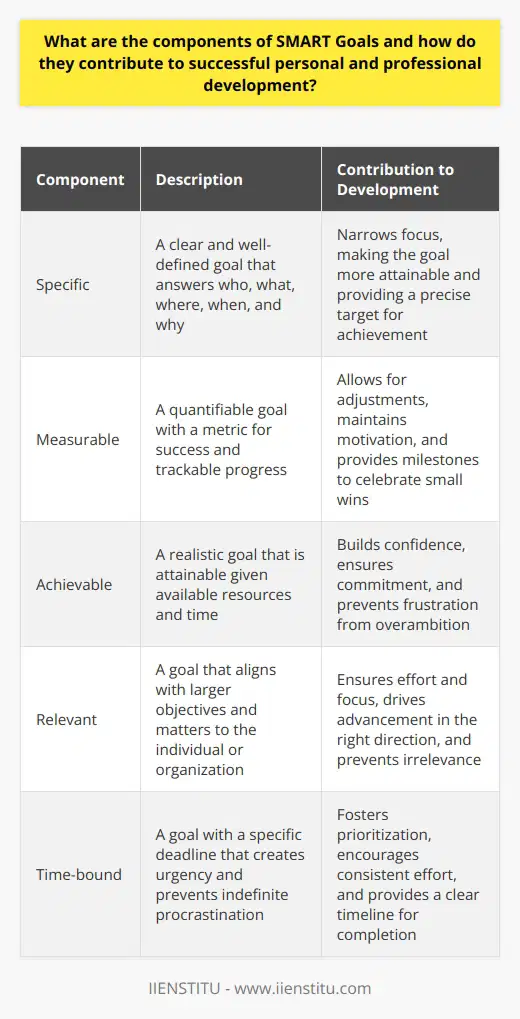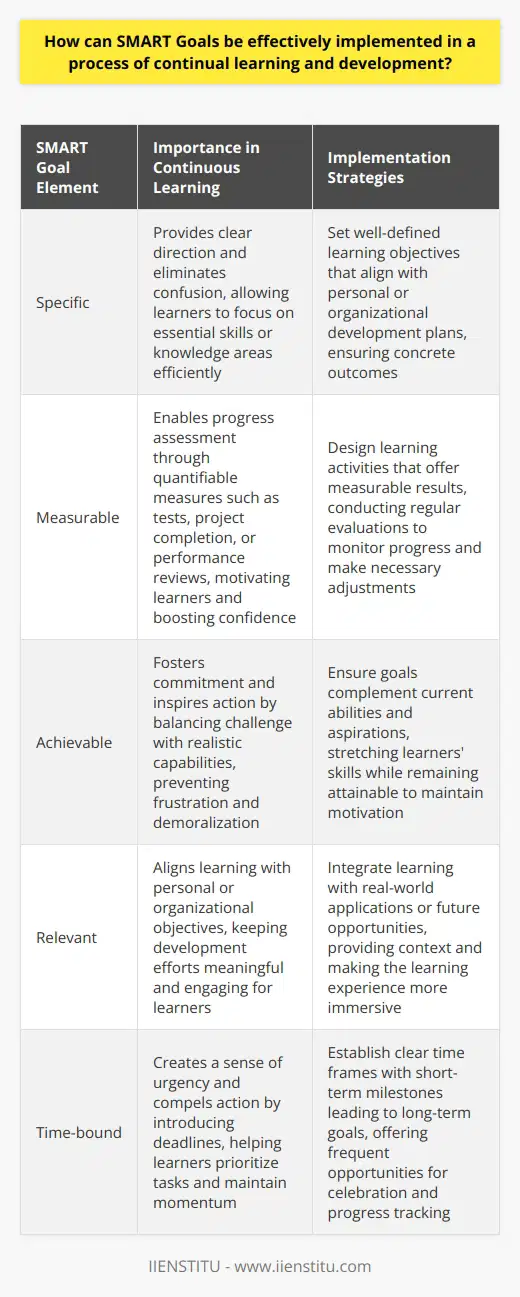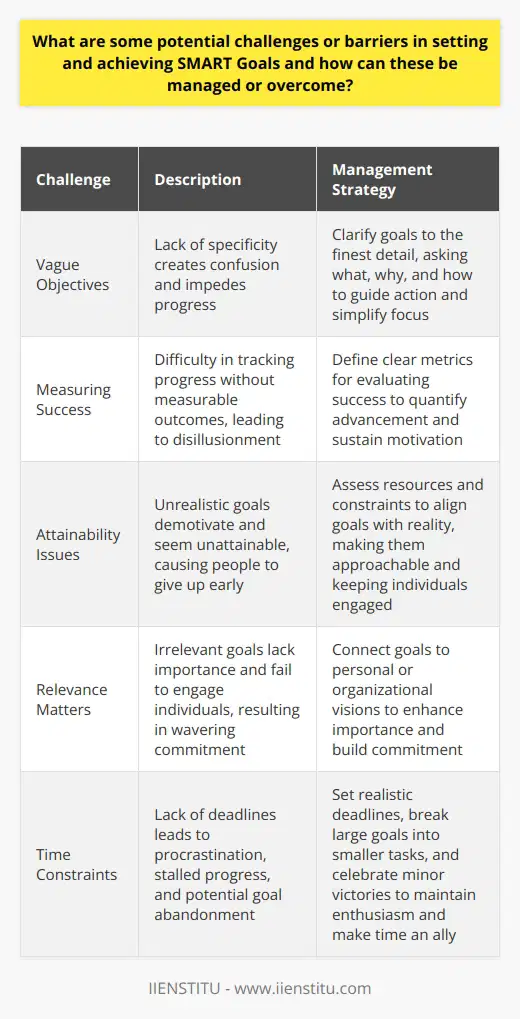
Setting goals is a crucial part of personal and professional development. It provides a clear direction and benchmarks for success. Among the various goal-setting frameworks, SMART Goals stand out for their effectiveness and practicality. SMART is an acronym that outlines a strategy for setting objectives that are Specific, Measurable, Achievable, Relevant, and Time-bound. The importance of setting SMART Goals cannot be overstated as they present a structured and trackable way to achieve what you set out to do, whether it's improving your personal life, advancing your career, or driving a business forward.
This article offers an in-depth exploration of the SMART Goals methodology and demonstrates how you can navigate your way to success by applying these principles.
Delving into SMART Goals: A Comprehensive Explanation

Specificity in SMART Goals
When we set goals, vagueness is an adversary that often leads to confusion or lack of direction. To counter this, SMART Goals demand specificity. To define specific goals with examples, consider a professional wishing to enhance their qualifications through an hr certification course. A specific goal would be, "Enroll in an HR certification course by the end of the next quarter," rather than a vague "Improve HR knowledge." Such clarity simplifies strategizing the path forward.
The importance of specificity in goal setting is anchored in its ability to focus efforts and resources efficiently, making the goal tangible and actionable. The more precise you are, the higher the chances of actually achieving the goal.
Measurability in SMART Goals
Goals should have criteria for measuring progress. By incorporating measurability, one can monitor advancement and stay motivated. Measurable goals answer the questions of quantity, quality, and progress. For instance, if you aspire to complete online courses with certificates, a measurable goal would be, "Complete three online courses and obtain certificates within six months."
This metric will allow you to track progress over the set period. The importance of measurability is significant in tracking progress as it provides evidence of achievement, enabling you to adjust your action plan as needed to stay on course.
Understanding the Attainability Factor in SMART Goals
Setting attainable goals is essential to maintaining momentum and confidence. For a goal to be achievable, it must be realistic and attainable, considering the available resources and constraints. To elaborate on attainable goals with examples, suppose you aim to read 50 books in a year; however, your schedule only allows time for 30. The goal, therefore, should be adjusted to align with these realistic capabilities.
The role of attainability in making realistic plans is essential because it prevents discouragement that often comes with setting overly ambitious and unattainable goals. Achievable goals encourage persistence and involvement in the pursuit of success.
The Relevance Aspect of SMART Goals
The relevance of goals is tied to the larger objectives in one's life or organization's strategy. This means that goals should be aligned with overarching values and long-term aspirations. When understanding relevant goals with examples, consider an individual aiming to pivot their career. A relevant goal might involve them pursuing development in a field that resonates with their passions and long-term career prospects.
Why relevance is significant in aligning with the bigger picture is simple; it ensures that the efforts invested contribute to broad lifetime achievements and fulfillment, rather than being a distraction or unnecessary detour.
The Timely Aspect of SMART Goals
Lastly, goals must be time-bound. This implies setting a specific deadline for completion, which creates a sense of urgency and prompts action. Time-bound goals with examples can be seen in scenarios such as a student setting a target to apply for scholarships by the beginning of their final undergraduate semester. The importance of timing in achieving goals is crucial as it helps prioritize activities, avoid procrastination, and achieve more in shorter periods.
How To Align Hrm Strategy And Leadership To Create Successful Employer Brand
Burnout Syndrome And Stress Management Strategies For Personal Development
Crafting SMART Goals: A User-friendly Guide

Identifying and Defining the Goal
The first step in crafting a SMART Goal is to clearly identify what you want to accomplish. This step requires reflection and honesty about what is important and what success looks like for you. After identification, define the goal in specific terms, ensuring that it is meaningful and well-articulated. For instance, if you aim to become more proficient in digital marketing, a specific goal would be to master three different digital marketing tools by the close of the year.
Making the Goal Measurable
Once the goal is set, determine the metrics or indicators that will guide your measurement of progress. Establish clear criteria that will signal advancement or completion. In pursuing online education, the measurable aspect could be the number of online courses with certificates completed within a determined period.
Checking the Goal's Achievability
Assess whether the goal you have set is realistic given your current resources and constraints. If you find that it’s not, consider breaking it down into smaller, more manageable sub-goals. Being pragmatic about your goal's achievability can save you from potential disappointment and ensure progress.
Ensuring the Goal's Relevance
Ascertain that your goal is relevant not only to your personal values but also to your broader life or professional objectives. Goals that have personal significance are more likely to inspire action and perseverance. For example, if career progression is your broader objective, then undertaking an hr certification course could be a relevant and strategic step in that direction.
Setting a Timeline for Goal Accomplishment
Finally, establish a realistic timeline for your goal. This deadline acts as a commitment device and can fuel motivation. Whether it's a short-term or long-term goal, having a clear endpoint allows for better planning and prioritization of resources.
Pitfalls to Avoid When Setting SMART Goals
Setting Unachievable Goals
One common pitfall in goal setting is aiming too high without considering the feasibility of the goal. Setting unachievable goals can quickly lead to frustration and a feeling of failure. It is essential to set challenging yet attainable goals to maintain morale and drive.
Misalignment of Goals with Personal or Organizational Vision
Another mistake is setting goals that do not align with the larger personal aspirations or the organization's vision. Misaligned goals can result in wasted effort and resources. Always ensure that your goals contribute positively to the bigger picture and your own values.
Neglect of Timelines or Setting Unrealistic Timelines
Failing to set a timeline or setting an unrealistic timeline can either lead to procrastination or unnecessary stress. A well-considered timeline can facilitate a structured approach to achieving goals and avoid these issues.
Real-life Examples and Success Stories of Setting SMART Goals
How SMART Goals are Utilized in Business Settings
In the corporate world, SMART Goals have been integral in successful project management, employee development, and strategic planning. Clear and measurable objectives have driven businesses toward greater innovation and efficiency, something evident in successful market expansions and product launches.
The Role of SMART Goals in Personal Life Success
Individuals who have applied SMART Goals to their personal development have found success in a range of areas, from health and fitness to financial planning and lifelong learning. These goals have equipped them to make substantial progress and experience significant transformations.
SMART Goals in Educational Settings
Educational institutions have leveraged SMART Goals to enhance student performance, streamline administrative functions, and improve teaching methods. These goals have been critical in driving better academic outcomes and institutional growth.
Frequently Asked Questions
What are the components of SMART Goals and how do they contribute to successful personal and professional development?
Understanding SMART Goals
SMART goals stand for Specific, Measurable, Achievable, Relevant, and Time-bound objectives. They form a guideline that outlines a clear path to success. Both personal and professional growth depend on well-defined goals. Let's break down each component and its contribution to development.
Specific
A goal must be clear. Vagueness leads to confusion. It should answer who, what, where, when, and why. Specificity narrows focus, making the goal more attainable. It tells a person exactly what needs achievement.
Measurable
A goal must be quantifiable. It requires a metric for success. Progress must be trackable. This allows for adjustments as needed. Measurable goals help in maintaining motivation. They provide milestones that celebrate small wins.
Achievable
A goal needs realism. It must be attainable given resources and time. Overambition leads to frustration. A reachable goal builds confidence. It also ensures commitment because it feels possible.
Relevant
A goal must align with larger objectives. It should matter to the individual or organization. Irrelevance leads to a lack of commitment. A relevant goal ensures effort and focus. It drives advancement in the right direction.
Time-bound
A goal requires a deadline. Deadlines create urgency. They prevent indefinite procrastination. Time Constraints foster prioritization. A time-bound goal encourages consistent effort.
SMART Goals and Development
SMART goals provide structure to aspirations. They transform vision into actionable steps. This systematic approach enables continual progression.
For personal development, SMART goals cater to self-improvement desires. They support habit formation and skill acquisition. One becomes accountable and disciplined.
For professional development, SMART goals align with career trajectories. They enhance job performance and facilitate goal-oriented learning. Employees can meet company expectations. Employers can track progress.
In conclusion, SMART goals are foundational to success. They guide individuals through a personal and professional growth journey. These components, when combined, deliver a strategic plan for development. They fuel motivation and enable objective tracking. They are critical in mapping out an effective route to reaching one's full potential.

How can SMART Goals be effectively implemented in a process of continual learning and development?
Understanding SMART Goals
SMART Goals stand for goals that are Specific, Measurable, Achievable, Relevant, and Time-bound. In the realm of continual learning and development, these elements become critical. They provide clear direction and measurable milestones. This ensures that improvement efforts align with individuals' and organizations' long-term aspirations.
Specificity Drives Focus
Specificity means goals must be clear and unambiguous. In learning, specificity eliminates confusion. It directs focus to the essential skills or knowledge areas. Individuals can then concentrate efforts efficiently.
Measurability Ensures Progress Tracking
Measurable goals allow for progress assessment. This includes tests, project completion, or performance reviews. They enable learners to appreciate progress over time. Quantifiable measures motivate and bolster confidence.
Attainable Goals Foster Commitment
Goals must be achievable. Unattainable goals demoralize learners. They lead to frustration. Achievable goals, on the other hand, encourage commitment. They inspire action. They balance challenge with realistic capabilities.
Relevance Keeps Learning Aligned
Relevance ties learning to personal or organizational objectives. It ensures that development efforts matter. It inspires learners to engage. It keeps activities tethered to broader goals.
Time-bound Goals Create Urgency
Time-bound goals introduce deadlines. They create a sense of urgency. They compel action. They help prioritize learning tasks over other activities.
Implementation of SMART Goals in Continuous Learning
Set Clear Learning Objectives
Start by identifying precise skills or knowledge to acquire. These align with career or personal development plans. Goals should have concrete outcomes. This facilitates focus.
Design Measurable Learning Activities
Select activities that offer measurable results. Use tests, simulations, or projects. Their outcomes should reflect learning gains. Regular evaluations keep progress in check.
Align Goals with Capabilities and Aspirations
Ensure goals complement current abilities and aspirations. They should stretch abilities. Yet, they must remain within reach. This balance maintains motivation.
Integrate Learning with Real-world Outcomes
Relate learning to real-world applications or future opportunities. This boosts relevance. It provides context. It makes learning more immersive.
Set Time Frames for Achievement
Establish clear time frames. Short-term milestones can lead to long-term goals. They offer frequent opportunities for celebration. They maintain momentum.
Monitor and Reflect on Progress
Track progress rigorously. Use journals, progress reports, or digital tools. Reflection allows for course corrections. It promotes self-awareness.
Adapt Goals as Necessary
Remain flexible. Adapt goals as new information emerges. Adjust goals according to feedback and performance data.
Embed SMART Goals into Organizational Culture
Encourage a culture that values SMART goal setting. Offer training and resources. Support should be available. Recognition for goal attainment can also reinforce this culture.
Conclusion
Implementing SMART goals in continuous learning requires careful planning and ongoing management. It necessitates clarity, measurability, attainability, relevance, and timeliness. Integrating these principles enhances the efficacy of developmental efforts. It supports sustained advancement both for individuals and organizations. By adhering to these principles, continuous learning transcends from a passive to an active strategic pursuit. It weaves into the fabric of daily activities, fostering a culture of perpetual growth and development.

What are some potential challenges or barriers in setting and achieving SMART Goals and how can these be managed or overcome?
Understanding SMART Goals
SMART stands for Specific, Measurable, Achievable, Relevant, and Time-bound. These criteria guide the setting of objectives. They help ensure success. Yet, users often face challenges when applying SMART goals.
Identifying Challenges
Vague Objectives
Goals must be specific. Vague goals create confusion. They lack direction. Consequently, this impedes progress.
Measuring Success
Goals need measurable outcomes. Without them, tracking progress is difficult. This can lead to disillusionment.
Attainability Issues
Setting achievable goals is critical. Unrealistic goals demotivate. They seem unattainable. Thus, people give up early.
Relevance Matters
Goals should be relevant. Irrelevant goals lack importance. They do not engage individuals. Hence, commitment waivers.
Time Constraints
Time-bound goals create urgency. Without deadlines, procrastination sets in. Progress stalls. Eventually, goals might be abandoned.
Managing Challenges
Crafting Specificity
Clarify goals to the finest detail. Ask what, why, and how. Specificity guides action. It simplifies focus.
Setting Measurable Milestones
Define clear metrics for evaluating success. This quantifies advancement. It sustains motivation.
Ensuring Achievability
Assess resources and constraints. Align goals with reality. This makes them approachable. Individuals stay engaged.
Aligning with Relevance
Connect goals to personal or organizational visions. This enhances importance. It builds commitment.
Adhering to Timeliness
Set realistic deadlines. Break large goals into smaller tasks. Celebrate minor victories. This maintains enthusiasm. Time becomes an ally.
Overcoming Barriers
Accountability and Support Systems
Developing a support network is essential. Friends, family, and colleagues can provide accountability. They offer encouragement. They can push toward milestones.
Flexibility and Adaptation
Frequent goal review is necessary. Goals evolve. Be ready to adjust. Flexibility enables overcoming unforeseen challenges.
Continuous Learning
Mistakes offer learning opportunities. Embrace failure. Analyze it. Adjust goals accordingly.
Persistence
Persistence is key. Challenges will arise. Commitment to pushing through them is vital.
Applying this framework requires dedication. It necessitates reflection. It demands adaptability. Managing these complexities can lead to success with SMART goals.



